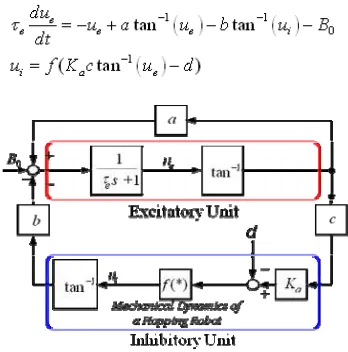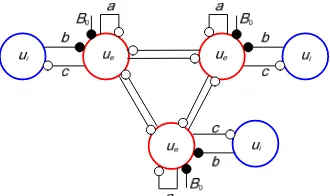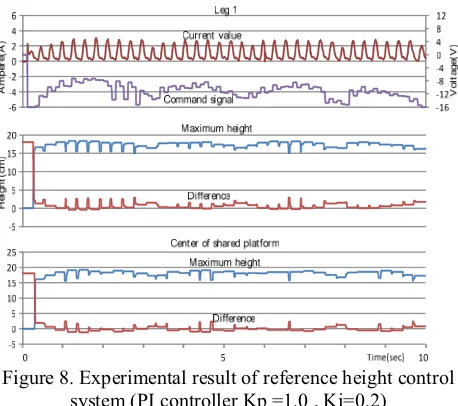Effectiveness of Reference Height Control System
for Tripod Hopping Robot
A.M. Kassim
Universiti Teknikal Malaysia Melaka, 76100 Durian Tunggal, Melaka, Malaysia
M.F.Miskon
Universiti Teknikal Malaysia Melaka, 76100 Durian Tunggal, Melaka, Malaysia
N.H.A. Rahim
Universiti Teknikal Malaysia Melaka, 76100 Durian Tunggal, Melaka, Malaysia
T.Yasuno
The University of Tokushima 2–1 Minamijosanjima–cho Tokushima, 770–8506 JAPAN [email protected]–u.ac.jp
Abstract— In this paper, the generation of vertical jumping motion for tripod hopping robot through reference height control system method in order to converge the differences of reference height for each leg of tripod hopping robot is discussed. The proposed control system is designed using MATLAB/ Simulink which is consisted of maximum height detector, PI controller system in the system of Central Pattern Generator (CPG). By using the approached method, tripod hopping robot can maintain the hopping motion and control the jumping height to achieve the reference height. As the result, we evaluate the effectiveness of CPG networks to keep the stability of tripod hopping robot besides of confirm the validity of using reference height control system to generate moving capability at different reference height.
Keyword— Tripod hopping robot, Reference height control system
I. INTRODUCTION
Physiological experiments suggest that basic locomotors patterns of most living bodies such as walking, flapping, flying and swimming are generated by CPGs which generates rhythmic activities [1]. CPG is neural networks that can endogenously produce rhythmic patterned outputs; these networks underlie the production of most rhythmic motor patterns. The periodic activities of the CPG which are initiated by a burst from the higher motor centre induce the muscle activities. After the initiation of the locomotion, the activities of the CPG are affected by sensory signals which show the bending of the body and so on [2]. The proactive sensory feedback plays an important role in the shaping and coordination of the neural activity with the mechanical activity. Moreover, neurophysiologic studies of insect locomotion suggest that sensory feedback is involved in patterning motor activities and that is more than modulation of the centrally generated pattern [3]. The construction of useful legged
type locomotion comes from the system which able to control joint motion, monitor and manipulate balance, generate motions to use known footholds, sense the terrain to find good footholds and calculate negotiable foothold sequences.
M.H Raibert who has done research on one-legged hopping robot is the main contributor of hopping robot research [4]. It is consisted body and leg which is equipped with a pair of pneumatic actuators to exert torque between the leg and the body about to hip. In addition, discrete dynamic system theory has been discovered by Koditscheck and Buhler which analyze the dynamics of a simplified hopping robot that focused only on the vertical movement [5]. On the other side, Son et al. proposed a CPG model including the motor dynamic characteristic of an actuator for the purpose of implementing generation adaptive gait patterns for quadruped robot under various environments. Meanwhile, for application on quadruped hopping robot, Kondo et. al proposed the CPG networks to generate continuous jumping motion patterns [6 - 11].
In this paper, the generation of vertical hopping motion by achieving the reference height which has been set while jumping continuously using the adaptive CPG is discussed. Reference height control system method is approached in order to converge the steady state error which existed on each jump according to the reference height for each leg of the developed tripod hopping robot.
II. DEVELOPED TRIPODHOPPING
A. Robot Construction
Figure 1 shows the developed tripod hopping robot which its overall length and width is 26cm, overall height is 40cm and its weight is 4.59kg. The robot is consisted of three legs which are connected to a shared platform. A DC geared motor (12 V, 200min-1, 0.098Nm), a crank and a spring are joined together to form a leg which is attached to the 2011 4th International Conference on Mechatronics (ICOM), 17-19 May 2011, Kuala Lumpur, Malaysia
crankshaft. DC geared motor plays as the main role of the tripod hopping robot performance. DC amplifier is used to drive the DC geared motor to provide torque through the crank to push the platform.
Figure 1. Developed tripod hopping robot
Figure 2 presents the hopping mechanism for developed tripod hopping robot. From this figure, the periodical hopping motion of tripod hopping robot can be achieved from step 1 to step 4 respectively. The periodic force of motor torque can be transmitted to the spring. By applying required force at suitable time to the spring, floor repulsive force can be used in order to generate the continuous hopping motion of the tripod hopping robot.
Figure 2. Hopping mechanism
B. Experimental Setup
Figure 3 shows the experimental setup for evaluation of the tripod hopping robot. The system needs two different computers which is connected through Ethernet to each other. One of the computers is included with MATLAB/Simulink model functions as the host computer while the other one plays as xPC target computer.
Figure 3. Experimental Setup
The model which built by realtime workshop is downloaded to the xPC target computer and run by using realtime OS. The measurement of sensor on each leg will be send to the A/D converter and input to the xPC Target Computer as the experimental results.
III. SYSTEM CONFIGURATION
A. CPG model
Figure 4 shows the block diagram of the CPG model which is used for the tripod hopping robot. Mechanical dynamics of the leg is included into the inhibitory unit. Parameters ue and ui denotes the internal state of the excitatory unit and inhibitory unit, b and c denotes the intrinsic excitatory and inhibitory coupling parameter, a
denotes the excitatory coupling factor while Bo denotes the constant bias input. The output of the inhibitory unit corresponds to the platform position of each leg and is applied to the excitatory unit through a nonlinear function tan-1 (ui) and the feedback gain b which is formulated as
Figure 4. Block diagram of CPG model.
where f (*) is the mechanical dynamics of the hopping robot’s leg, Ka is the gain constant of the DC amplifier and d is the external disturbances which is the floor repulsive force for this case. CPG may change the amplitude and frequency of internal states ue and ui by only hanging the coupling parameters a, b, c, the time constant IJe and the mechanical dynamics of the hopping robot arbitrarily.
B. Reference height control system
the hopping motion and control the hopping height to achieve the reference hopping height by adding a feedback loop through a fixed gain PI controller. The joint actuator is driven by the control system in order to realize the reference hopping position generated by the PI controller on each leg.
Deduction of sensory feedback signal hmax of the ultrasonic sensors on each legs from the reference height
hreff gives the value of steady state error hdiff which represents the command signal. In control engineering, a PI controller is a feedback controller which drives the plant to be controlled with a weighted sum of error hdiff and integral of that value. The integral term in PI controller causes the steady state error to be zero for a step input.
Figure 3.4 Block diagram of reference height control system
C. CPG networks
Configuration of typical CPG network is shown in figure 6. Cooperative oscillations among the CPG is required and continuous hopping performance of the tripod hopping robot is achievable by applying the same periodic force to the spring of the robot.
Figure 6. CPG networks for tripod hopping robot
IV. EXPERIMENTAL RESULTS
In order to evaluate the validity and the performances of the proposed reference height control system for the tripod hopping robot, the experiment was conducted. At the same time, these experiments also to adjust the best value of PI gain from the PI controller system according to the changes of size and weight of developed tripod hopping robot from the developed quadruped hopping robot [6-10]. These experiments are conducted to evaluate the maximum height detector system and PI controller system which included in the proposed system. The values of CPG networks coupling parameters proposed for the experiments are a = 0.1, b = 2, c
= 1, Bo = 0.01 and IJe = 0.1.
The first experiment is conducted for reference height control system by using P controller only. This method is approached in order to adjust the best value of P gain in order to generate the continuous hopping performances while achieving the reference height which has been set. In other words, this experiment is conducted to evaluate the effectiveness of P controller for the tripod hopping robot to achieve the reference hopping height. P gain value is tuned manually from Kp = 0.5 to the best value while KI = 0. The best jumping performances are observed and the jumping height data is analysed. The best value of gain P will be remained for the second experiment. As the result, the best value of P gain which is acquired is K = 1.0.
Figure 7 shows the experimental results for leg 1 and center of the platform for developed tripod hopping robot using P controller only. The experimental results shows the data of jumping height, command signal, difference (steady state error), feedback signal, and center jumping height for leg 1 while conducting the experiments. The whole experiment for evaluating the stability of the proposed reference hopping height control system is conducted in 10sec.
The evaluation of PI controller in order to converge the remained steady state error to zero is conducted as the second step of experiment. The best value for I gain is evaluated by setting P and I gain from
KP = 1.0 and KI = 0 in order to converge steady state error to zero. Analyzing whether the steady state error is converged into zero or not help to determine the best value of I gain. Then, the similar method which used to determine the P gain is conducted to acquire the best value of gain I by increasing the value KI = 0.1 each experiment.
Figure 8 shows the experimental results of using PI controller system for the developed tripod hopping robot. From the experimental result, it is proved that the developed tripod hopping robot can achieve the reference height which is set to each leg by using PI controller. The tripod hopping robot jumped with synchronizes and the same frequency of each jumping can be seen in result of current value at figure 8.
Figure 8. Experimental result of reference height control system (PI controller Kp =1.0 , Ki=0.2)
From the result, it can be seen that the frequency for each jumping is same on all legs except some current value is not detected from leg 1. This condition represents that leg 1 is floating while leg 2 and leg 3 are on the floor. At this condition, higher voltage is sent to leg 2 and leg 3 so that higher jumping performance can be done in order to stable the body balances of the developed tripod hopping robot from tumble. Therefore, the effectiveness of leg 2 and leg 3 to balance the body of the developed tripod hopping robot is confirmed.
V. CONCLUSIONS
In this paper, we proposed a method which is reference height control system in order to conduct the reference hopping height on each jumping period. The direction of tripod hopping robot’s body inclination is
affected by the difference of reference hopping height on each leg of the tripod hopping robot. As the result, successful moving performances while hopping continuously and rhythmically are determined. Besides that, effectiveness of CPG networks in generating continuous hopping motion and keep the stability of tripod hopping robot from tumble ahead is also evaluated.
In future, we aim to investigate the moving motion control system of the tripod hopping robot for better moving motion performance. Any possibilities to achieve higher hopping height than current achievement also will be counted. Besides that, we would like to build simulation model for the tripod hopping robot and by using learning algorithm we aim to acquire the CPGs parameters and coupling parameters of CPG networks for hopping at arbitrary place.
ACKNOWLEDGEMENT
This research was supported by grant from Universiti Teknikal Malaysia Melaka award no. PJP/2010/FKE (25C) S726 and also technically support from Yasuno laboratory member, The University of Tokushima, Japan.
REFERENCES
[1] Grillner S,Neurobiological Bases of Rhythmic Motor Acts Invertebrates, Science, Vol.228, pp.143-149, 1985.
[2] William TL, Sigvardt KA, Kopell N, Ermentrout GB, Remler MP; Forcing of Coupled Nonlinear Oscillator: Studies of Intersegmental Coordination in the Lamprey Locomotor Central Pattern Generator, Journal of Neurophysiol, No.64(3), pp 862-871, 1990.
[3] Bassler U; On the Definition of the Central Pattern Generator and its Sensory Control, Biol. Cybernatics, No.54, pp 65-69, 1986.
[4] M.H Raibert; Legged Robot That Balance, MIT Press, Cambridge, Massachusetts, 1986
[5] D.E Koditscheck and M. Buhler; Analysis of a Simplified Hopping Robot, Int. Journal of Robotics Res., Vol.10(6), pp.587-605,1991. [6] Anuar Bin Mohamed Kassim, Takashi Yasuno, Hironobu Harada and
Akinobu Kuwahara; Adaptive Jumping Motion Control for Quadruped Hopping Robot Using CPG Network, 13th Intelligent Mechatronics
Workshop Kagawa, Japan No.13, pp.160-163, Sept.8, 2008.
[7] Anuar Bin Mohamed Kassim and Takashi Yasuno• •Motion Control for Quadruped Hopping Robot Using CPG Network with Mechanical Dynamics• •2009 National Meeting Record of The Institute of Electrical and Related Engineers, Hokkaido, Japan No.29-4• •pp.4-S21-8, March 19• •2009.
[8] Anuar Bin Mohamed Kassim• •Takashi Yasuno and Akinobu Kuwahara
• •Two-Dimensional Moving Control of Quadruped Hopping Robot Using Adaptive CPG Networks• •2009 The Section of Electronic, Information and System of National Meeting Record of The Institute of Electrical and Related Engineers, Tokushima,Japan No.GS5-1• • pp.118-121, Sept. 4• •2009.
[9] Bin Mohamed Kassim. A.; T. Yasuno "The Moving Control of Quadruped Hopping Robot Using Adaptive CPG Networks"4th IEEE International Conference on Robotics, Automation and Mechatronics, Singapore, pp. 581-588, June 2010.
[10] Y. Son, T. Kamano, T. Yasuno, T. Suzuki, and H. Harada: Generation of adaptive gait patterns for quadruped robot Using CPG Network, Electrical Eng. Jpn., Vol.115, No.1, pp. 35–43, 2006.


